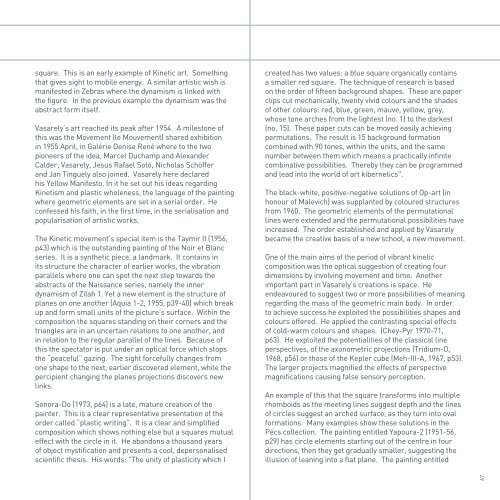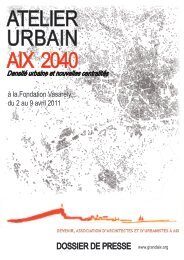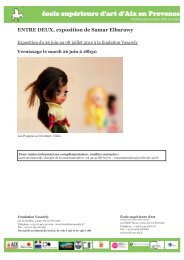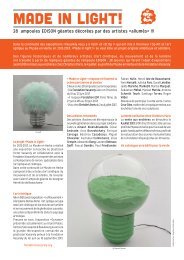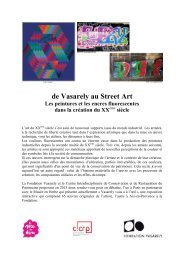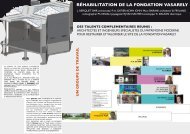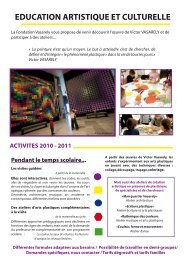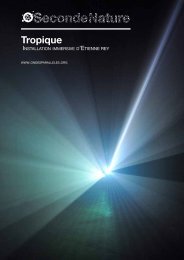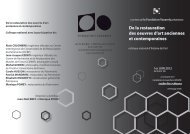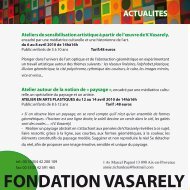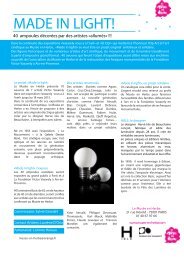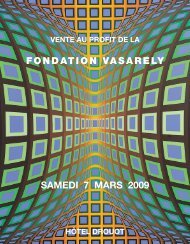Victor Vasarely - Fondation Vasarely
Victor Vasarely - Fondation Vasarely
Victor Vasarely - Fondation Vasarely
Create successful ePaper yourself
Turn your PDF publications into a flip-book with our unique Google optimized e-Paper software.
square. This is an early example of Kinetic art. Something<br />
that gives sight to mobile energy. A similar artistic wish is<br />
manifested in Zebras where the dynamism is linked with<br />
the figure. In the previous example the dynamism was the<br />
abstract form itself.<br />
<strong>Vasarely</strong>’s art reached its peak after 1954. A milestone of<br />
this was the Movement (le Mouvement) shared exhibition<br />
in 1955 April, in Galérie Denise René where to the two<br />
pioneers of the idea, Marcel Duchamp and Alexander<br />
Calder; <strong>Vasarely</strong>, Jesus Rafael Sotó, Nicholas Schöffer<br />
and Jan Tinguely also joined. <strong>Vasarely</strong> here declared<br />
his Yellow Manifesto. In it he set out his ideas regarding<br />
Kinetism and plastic wholeness, the language of the painting<br />
where geometric elements are set in a serial order. He<br />
confessed his faith, in the first time, in the serialisation and<br />
popularisation of artistic works.<br />
The Kinetic movement’s special item is the Taymir II (1956,<br />
p43) which is the outstanding painting of the Noir et Blanc<br />
series. It is a synthetic piece, a landmark. It contains in<br />
its structure the character of earlier works, the vibration<br />
parallels where one can spot the next step towards the<br />
abstracts of the Naissance series, namely the inner<br />
dynamism of Zilah 1. Yet a new element is the structure of<br />
planes on one another (Aquia 1-2, 1955, p39-40) which break<br />
up and form small units of the picture’s surface. Within the<br />
composition the squares standing on their corners and the<br />
triangles are in an uncertain relations to one another, and<br />
in relation to the regular parallel of the lines. Because of<br />
this the spectator is put under an optical force which stops<br />
the “peaceful” gazing. The sight forcefully changes from<br />
one shape to the next, earlier discovered element, while the<br />
percipient changing the planes projections discovers new<br />
links.<br />
Sonora-Do (1973, p64) is a late, mature creation of the<br />
painter. This is a clear representative presentation of the<br />
order called “plastic writing”. It is a clear and simplified<br />
composition which shows nothing else but a squares mutual<br />
effect with the circle in it. He abandons a thousand years<br />
of object mystification and presents a cool, depersonalised<br />
scientific thesis. His words: "The unity of plasticity which I<br />
created has two values: a blue square organically contains<br />
a smaller red square. The technique of research is based<br />
on the order of fifteen background shapes. These are paper<br />
clips cut mechanically, twenty vivid colours and the shades<br />
of other colours: red, blue, green, mauve, yellow, grey,<br />
whose tone arches from the lightest (no. 1) to the darkest<br />
(no. 15). These paper cuts can be moved easily achieving<br />
permutations. The result is 15 background formation<br />
combined with 90 tones, within the units, and the same<br />
number between them which means a practically infinite<br />
combinative possibilities. Thereby they can be programmed<br />
and lead into the world of art kibernetics".<br />
The black-white, positive-negative solutions of Op-art (in<br />
honour of Malevich) was supplanted by coloured structures<br />
from 1960. The geometric elements of the permutational<br />
lines were extended and the permutational possibilities have<br />
increased. The order established and applied by <strong>Vasarely</strong><br />
became the creative basis of a new school, a new movement.<br />
One of the main aims of the period of vibrant kinetic<br />
composition was the optical suggestion of creating four<br />
dimensions by involving movement and time. Another<br />
important part in <strong>Vasarely</strong>’s creations is space. He<br />
endeavoured to suggest two or more possibilities of meaning<br />
regarding the mass of the geometric main body. In order<br />
to achieve success he exploited the possibilities shapes and<br />
colours offered. He applied the contrasting special effects<br />
of cold-warm colours and shapes. (Chey-Pyr 1970-71,<br />
p63). He exploited the potentialities of the classical line<br />
perspectives, of the axonometric projections (Tridium-O,<br />
1968, p56) or those of the Kepler cube (Meh-III-A, 1967, p53).<br />
The larger projects magnified the effects of perspective<br />
magnifications causing false sensory perception.<br />
An example of this that the square transforms into multiple<br />
rhomboids as the meeting lines suggest depth and the lines<br />
of circles suggest an arched surface, as they turn into oval<br />
formations. Many examples show these solutions in the<br />
Pécs collection. The painting entitled Yapoura-2 (1951-56,<br />
p29) has circle elements starting out of the centre in four<br />
directions, then they get gradually smaller, suggesting the<br />
illusion of leaning into a flat plane. The painting entitled<br />
67


